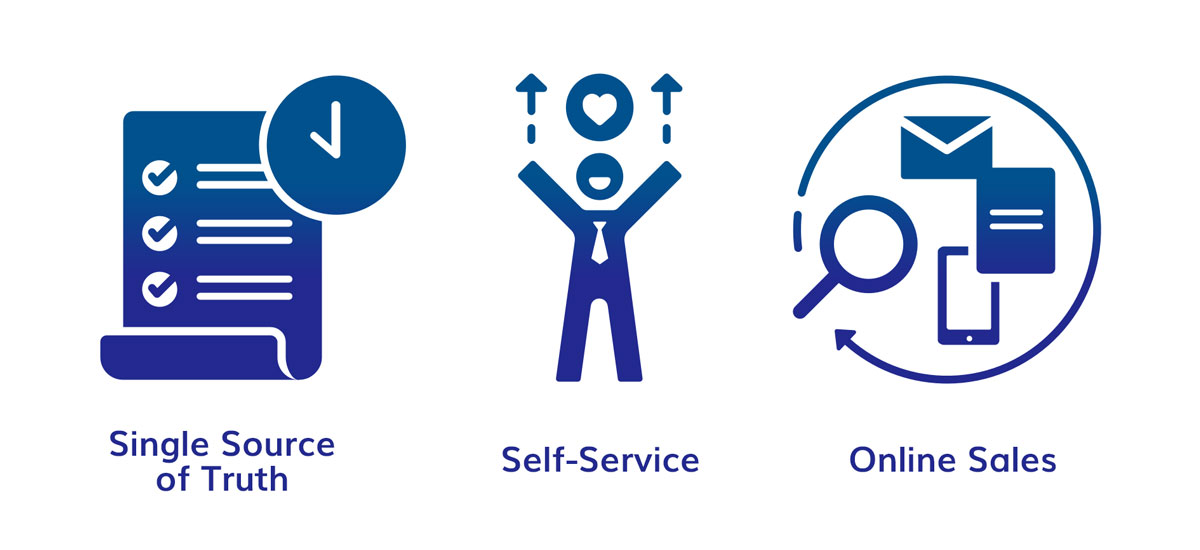The Manufacturing industry has always kept a strong relationship with technology, and because of this, it has become a source of breakthroughs and worldwide mindset changes. It’s an industry that was data-driven before any other industry was; they have paved the way for other industries and markets to follow its steps. This is captured in their methodologies and mindsets: their continuous improvement mindset efforts keep internal operations slim and effective, learning directly from the data and information they produce every day. These are the foundations of a successful manufacturing portal.
Having a leadership position has its setbacks. Manufacturing organizations face unique challenges regarding knowledge management and systems communications due to the kinds of services they both offer and consume from a data perspective. It heavily relies on third-party services, which exist to feed product information, pricing, specifications, and schematics into a “system” that is intended to be used by humans and bots alike. Additionally, organizations need to audit those feeds and include proprietary information that only lives with the individual manufacturer.

Users of those systems also navigate an experience or “Portal” based on their own individual needs, which can vary based on job role: buyer, seller, maintenance, supplier, marketing, sales, etc. Each individual role navigates a complete experience differently. While technologically advanced, those systems are not necessarily easy to handle, they may require high technical skills to be operated, and they may create process blockers on their own.
So, what if the experience isn’t holistic? How do gaps in information consumption impact the overall business success of a “good” Manufacturing Portal experience? It may be difficult at first glance to understand how a good digital experience in a portal or system impacts productivity and effectiveness, but its benefits are clear: it resolves confusion and disorganization between key users, it ensures there’s standardization in the information received, and sent, and it helps to reduce time and resources consumed in the overall process (yes, the time invested in fulfilling a goal or action in a Portal).
Core Areas of Manufacturing Portals
For the purposes of this post, we will focus on three core areas to get right when talking about a successful Manufacturing Portal. There is a multitude of additional steps and concepts to cover, but we will touch on the following items:
- Single Source of Truth
- Self-Service
- Online Sales

Single Source of Truth
Every organization has multiple layers of information that can potentially feed a knowledge base; worse yet, multiple sources actually feed said “master” system. Conflicting content, outdated resources, and gaps in processes fail to allow users the chance to maximize what is accurate, what is new, and what is old. Forcing an audit and providing a process for data collection that is “truth” requires an Admin level of oversight to collectively empower a workforce to trust what information they have access to is correct.
The final rendered experience can and should be the actual source of truth. Users of the Manufacturing Portal should be able to trust that they can not find this kind of content anywhere else.
Self-Service
Self-service means fulfilling a digital process with autonomy. It’s the ability to access key information about Company, Services, Features, Offerings, Solutions, and Questions that allow an employee, partner, or supplier to better answer pressing questions without having to rely on a SME (Subject Matter Expert). Users of a Manufacturing Portal shouldn’t have to rely on a dedicated Help Center of humans to answer their questions about information within a Portal experience; you will have “human blockers” in every important process of your company. To resolve this, resources should be tapped to create those help areas based on industry-specific commonalities.
If you engage with users of the manufacturing portal to ask them very specific questions about content, navigation, and structure, you can share that feedback with the entire audience of the Portal. Do not hide content, but most importantly, do not force your users to hunt for information that should be readily available to them. That’s the opposite of productivity.
So, make sure to include page-specific help but also provide them a dedicated location within the Portal to peruse text, videos, and infographics to better assist them in the overall experience.
Online Sales Environment
Let’s talk about e-Commerce. An e-Commerce solution that is populated by the Single Source of Truth and tied to an inventory of products. Related content should sit on the same screen as the ability to purchase or acquire a product. Product information is different than Product content. How a product interacts with a separate entity or how a product relates to a separate entity is just as valuable, if not more, than Product information at face value. Product reviews and FAQs about a particular product should be integrated into an overall catalog. You shouldn’t need a Sales department if you have your Single Source of Truth, Product information, and Self-Service strategy implemented via a store framework; again, a “human blocker”.
The Sales organization should point you to that experience and promote new items as they become available, and offer quality assessment, but only if the user requires it. Analytics should also be used to determine where users are finding products, how they are navigating to those areas of interest, where they are getting stuck/lost, and how a user journeys to and arrives at a final purchase.
Use the data you are collecting to your users’ benefit. Fix things that are broken. Correct things that are buried. Expand on topics or subjects that are light on information but receive a large percentage of traffic. Evolve your Portal: do not launch and assume your organization got it completely correct on the first go. As any other internal process operates, apply and promote continuous improvement.

We haven’t even scratched the Surface of Manufacturing information in Digital Experience Platforms or using a Cloud (PaaS), but we may later on in a follow-up post. Fundamentals in understanding your diverse audience will generate greater engagement and will create a solution that is needed for your users to do their jobs successfully. Give them quality content, allow them to find their own solutions, and give them a way to purchase/buy products intuitively. That way, you will have something people will want to log into, not have to log into.
Success with Your Manufacturing Portal: Next Steps
At Base22, we love portal and intranet projects. We have over 15 years of experience as well as tools and knowledge that can help your organization avoid costly pitfalls. If your manufacturing company has upcoming portal project, whether it is a redesign, a migration, an upgrade, integration needs, or just launching a new solution, contact us. We would love to discuss how we can help you with your digital challenges.

Want to drive business growth?
Request a free UX Health Check for one of your company's digital assets.
request it here


